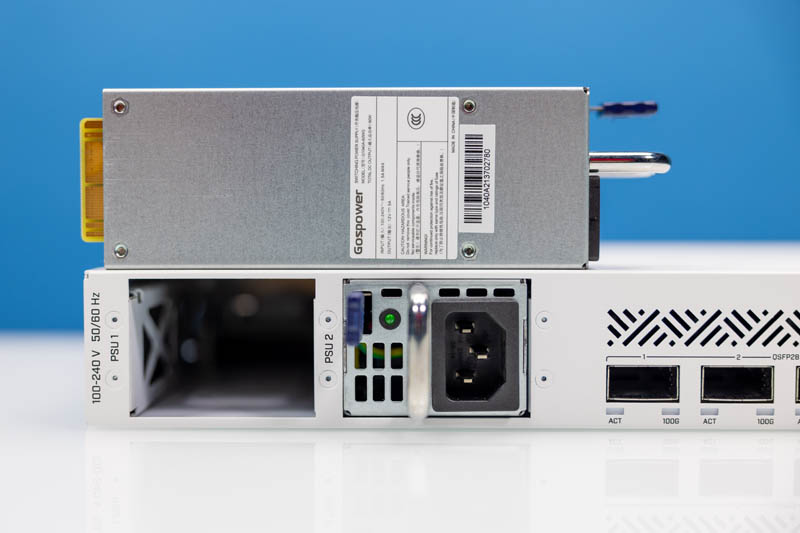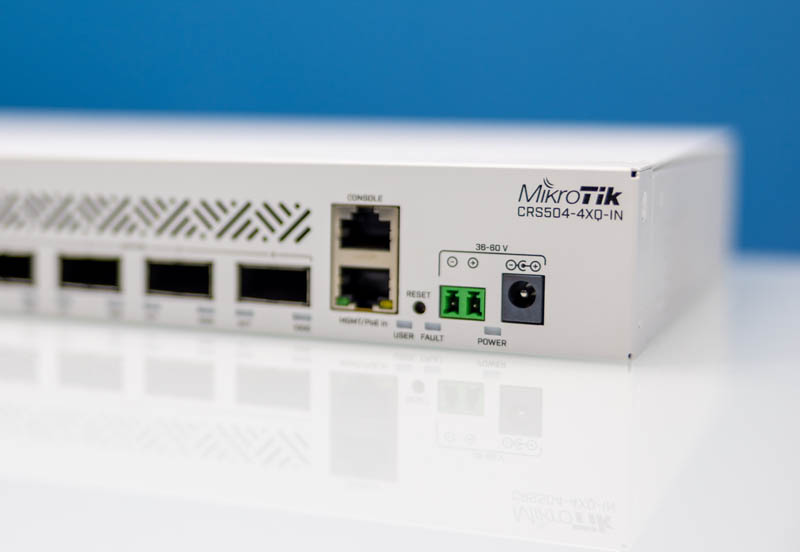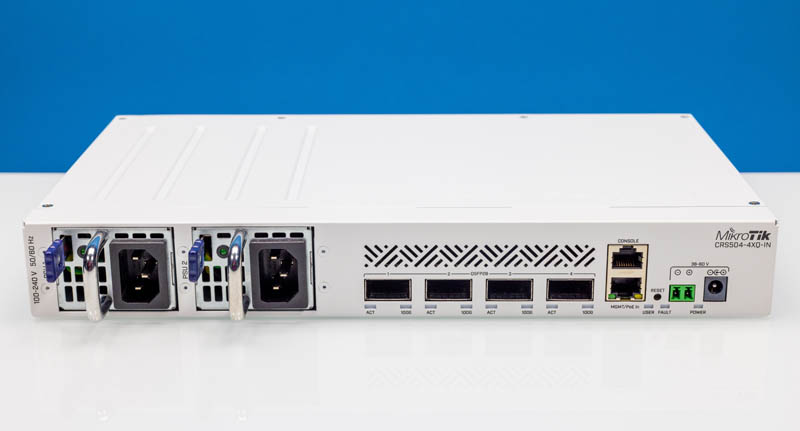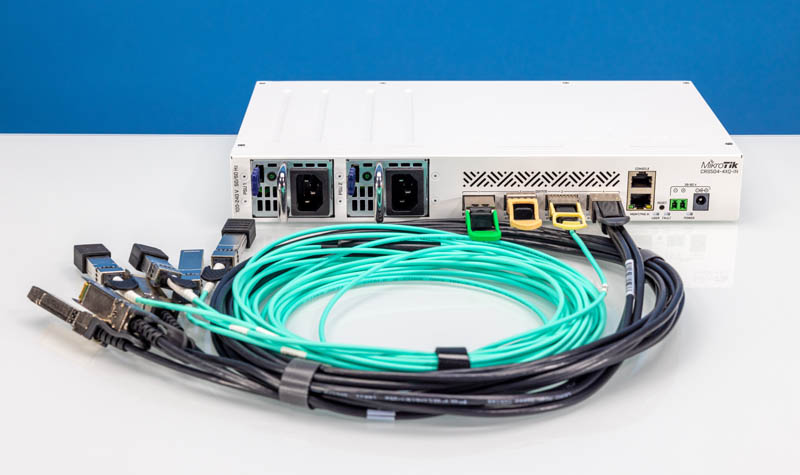MikroTik CRS504-4XQ-IN Power Consumption and Noise
In terms of power consumption, the 60W PSUs are plenty. MikroTik rates the switch at 45W, and we saw just under that in our testing.

The breakdown is something like the switch uses ~11W at idle without any data cables. Adding 100GbE optical modules generally added ~5W each, so the switch used around 30W with 4 QSFP28 optics installed, but without traffic being passed. That leads to around 11W (what we observed) to 15W (max spec) for additional power consumption on the switch based on the amount it is utilized. Hopefully, that breakdown gives some sense of how much power consumption you can expect.
Still, let us get “real” for a moment. This entire switch uses notably less power than a NVIDIA BlueField-2 DPU with 2x 100GbE NIC ports. There are also a lot of different ways to power the switch, but we just used the AC power inputs.

The other side of this equation is the NIC side. 100GbE and 25GbE NICs have fallen in price dramatically, as with the PCIe Gen5 400GbE generations that take optics that have as much capacity as this entire switch, the 100GbE gear is now two generations old. That means we should see much lower-priced 100GbE and 25GbE NICs hit the market, especially on the excess and second-hand markets. Those 100GbE NICs also can use a lot of power. A typical 100GbE NIC with optics can use 25-27W inside a system. That is still much more power efficient than lower-speed networking, but it is part of the end-to-end upgrade power consumption. It also highlights just how low power this switch is since it is lower power than the NICs that go in servers pushing that same bandwidth.
In the video, we let you listen to the fans spinning at boot. At the same time, the switch often runs with fans at 0 RPM, even when modules are installed, if there is not a lot of traffic passing through the switch. This is very different from many of the larger 32x 100GbE switches that can be found relatively inexpensively online. It uses much less power and is much quieter.
Final Words
At some point, it is time to call this momentous. The MikroTik CRS504-4XQ-IN is not the fastest switch with the highest port count. Many can find higher-speed switches with more ports and features second-hand for less. While one may pay less up-front for second-hand switches, this MikroTik unit is going to be much lower power. It will be more compact. In terms of noise, these often run nearly silently.

If you want to start using 100GbE or 25GbE today, this is probably the switch to get in a small environment (assuming you are not creating a lab around RoCE.) In many ways it reminds us of the MikroTik CRS305-1G-4S+IN, except as a better value. The CRS305 was around $5/ 1Gbps, while this is closer to $1.75/ 1Gbps. If you do not need fast networking, then there is little reason to get a switch like this. If you are buying inexpensive 25GbE and 100GbE gear or are getting ready for the new Xeon D-1700/ D-2700, Snow Ridge, and Parker Ridge (you can see an 8-core Intel Atom Snow Ridge platform in the video with 2x 25GbE and 8x 1GbE), then this MikroTik CRS504-4XQ-IN may be perfect. It does not have the SFP28 cages, breakout cables are needed, but it is less than half the price of the MikroTik CRS518-16XS-2XQ-RM, making it much more attractive for homelab and SMB use.

Just to give you some sense, we received our first unit a few months ago. I now have two of these, and Patrick has five of them in various rooms in his home (he also has ~1700 fiber strands in his walls.) Overall, this feels like it is servicing an edge market for lower port count 100GbE and 25GbE switches, with SMB-friendly features like a GUI and low noise, at an attractive price point. It is hard not to like this package if you do not need higher port counts.
Where to Buy
We have purchased a bunch of these from Amazon. Here are affiliate links for which we may earn a small commission if you purchase through them (that is how we can buy these to review):
- MikroTik CRS510-8XS-2XQ-IN Amazon Affiliate link
- MikroTik CRS504-4XQ-IN Amazon Affiliate link




IF my old data center pals decide to give me a couple used 2U/4Node Rome quads in say 2025, THEN this switch (with a couple 100/25Gbit quad breakout cables) would make for an excellent $HOMElab upgrade in my 12U rack.
It’s a shame 100 GbE networking is so power hungry – with the exception of this switch obviously. I recently got hold of a Mellanox ConnectX-6 100 GbE NIC, and the Linux boot messages said the card was requiring 75 watts from the PCIe slot. Even with a quiet fan blowing directly on it, it got too hot to touch, so apparently a faster/noisier fan is needed.
Hopefully newer generations using less power will hit the second hand market soon so we can have 100 GbE at home without turning it into a deafening sauna.
As for MikroTik, my experience hasn’t been fantastic. I first bought a CRS309 (8x 10G switch) and it emitted a buzz and died when I powered it up and had to return it. The second item I bought was an RB5009 which wouldn’t power up, and it turned out they’d listed the wrong specs (since corrected) and said it supported PoE on ports it did not, so again I had to return it as it wasn’t possible to make it work in the scenario I had planned.
The replacement CRS309 worked well enough, but it annoys me that if you change the wrong settings, it can suddenly pass all traffic via the CPU and then without warning your throughput suddenly drops to hardly anything (as mentioned in the article). It’s only after reading the fine print do you discover that while many options and modes are available, only a handful will actually work at wire speed.
So while I used to think MicroTik made some pretty interesting hardware, I’m less keen these days given how much research you have to do over every little detail to make sure the product you’re buying can actually do things that go without saying in other products. I guess that’s just the cost of cheap hardware.
The main issue with Mikrotik is reliability, they still sell a switch that has know issues (CRS354), they still sell a router that tends to reboot/crash for unknown reason (CCR2004) and they seem to find this normal, they just need to find a software workaround..
You have threads on their forum spanning over two years about issues that never get fixed, essential features that get removed from ROS6 to ROS7 and take ages to be reimplemented.
Now their boxes have very nice features for the price, ROS / Winbox is something the big brands should take inspiration from but the fact that you never know how stable their device will be in your use case is really a concern.
Completely agree with netswitch. Its not reliability though its professional integrity.
I agree with netswitch. Having worked almost exclusively in the SMB market over the past decade Mikrotik products were always an option that never was. Their capability to price on paper was a no brainer, but the reality was always that the client would rather purchase supported “big name brand” equipment for double or more the price with peace of mind attached. The homelab and entry level seems to be the only real market they have presence in.
What network devices did you attach it to? Was there any issues with getting the QSFP28 ports to connect to other hardware on the other end? I am just learning about transceivers and it seems to be a minefield!
I have had one of these for the last 2 weeks, and my experience has so far not been great. The device is simple to set up, and with their recommended cables connects ok. However it has dropped out twice now with very little going on. The switch has simply crashed. Power down and up and it starts to work. I am running through various options, but running two connections with 1 QSFTP28 running at 40G -> 10G to a Unifi 48 port switch, and one port running at 100G->25G to a Intel based 710 based card, so its not exactly complex. I only have a few servers to add, but so far I cannot because of reliability. I will probably be jumping out soon and just spending proper cash on a bigger switch, as this has burned too much time now.
Hi, I am new to the networking space. Bought this switch for my home lab. And got 4 used Nic’s to test. I got a 10gb, a 25 gb(Broadcom), a Mellanox cx455a, and a Mellanox cx555a. The 10 and 25 gb nic works well with breakout cable from the crs504. My windows machine was able to recognize either the 10 or 25 gb nic. The other machine of the network is running Truenas and has driver for the 25gb nic. Smb access from windows to truenas was amazing compared to my previous setup of all 1 gb connections. However, I can’t get the cx455a nor the cx555a to work on Windows 11 nor Truenas. They even get recognized in Truenas. In Windows 11, they are recognized in Device manager after I ran the device drivers from Nvidia, but they don’t show up on the Ethernet list nor will they accept dhcp allocation. I manually set their ip and they are not recognized by the switch. RouterOs sees the dac cable on the switch end but no link. Can anyone help me to get the 100 nic’s working in windows?
Can a single QSFP28 port on the switch be split into combined 10Gbe and 25Gbe ports? For example 2x 25gbe and 2x 10gbe? Or must all be the same speed (which are split from one QSFP28 port on the switch)?